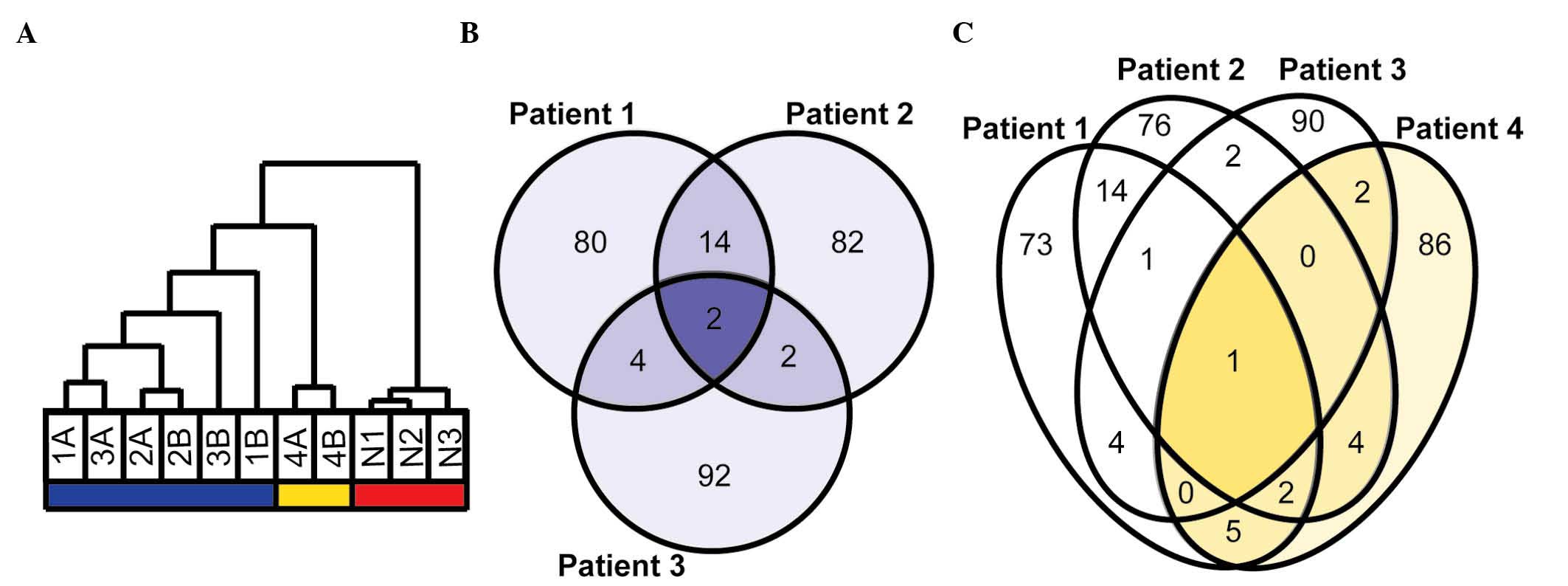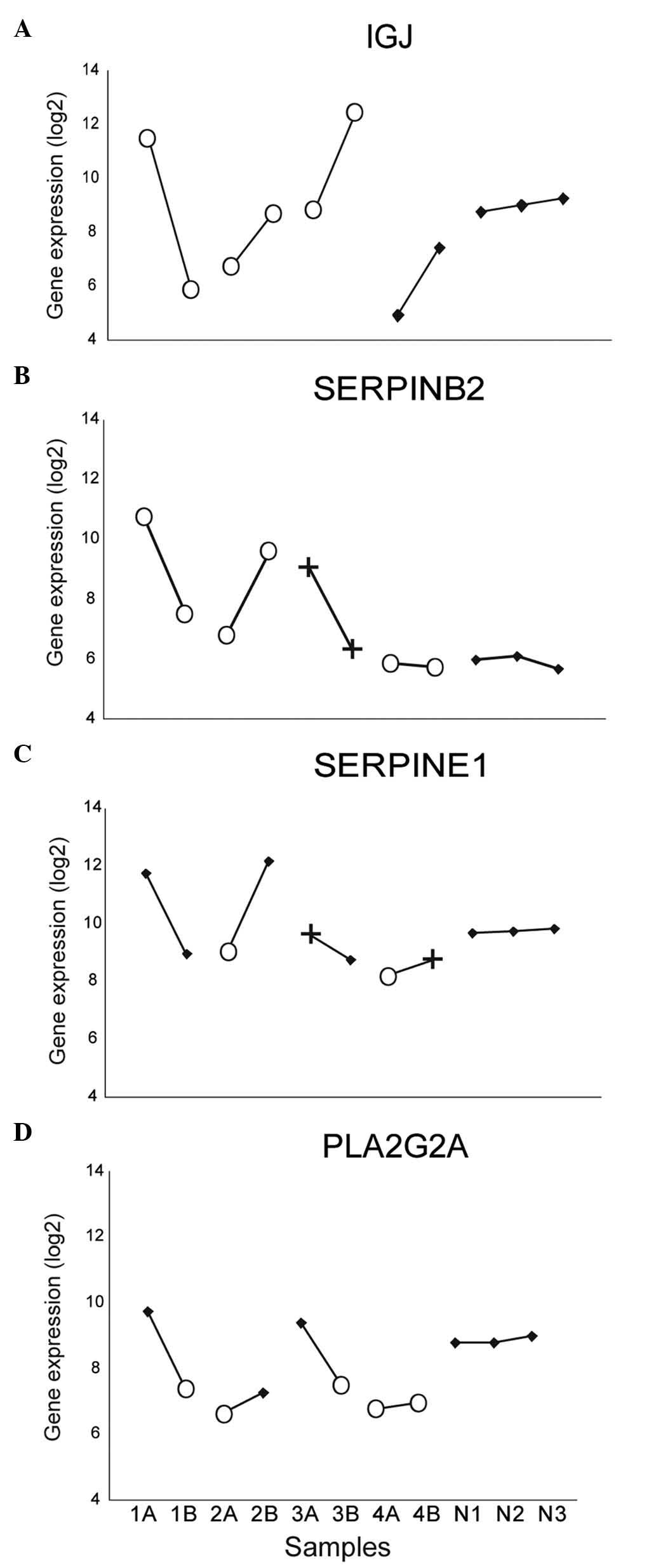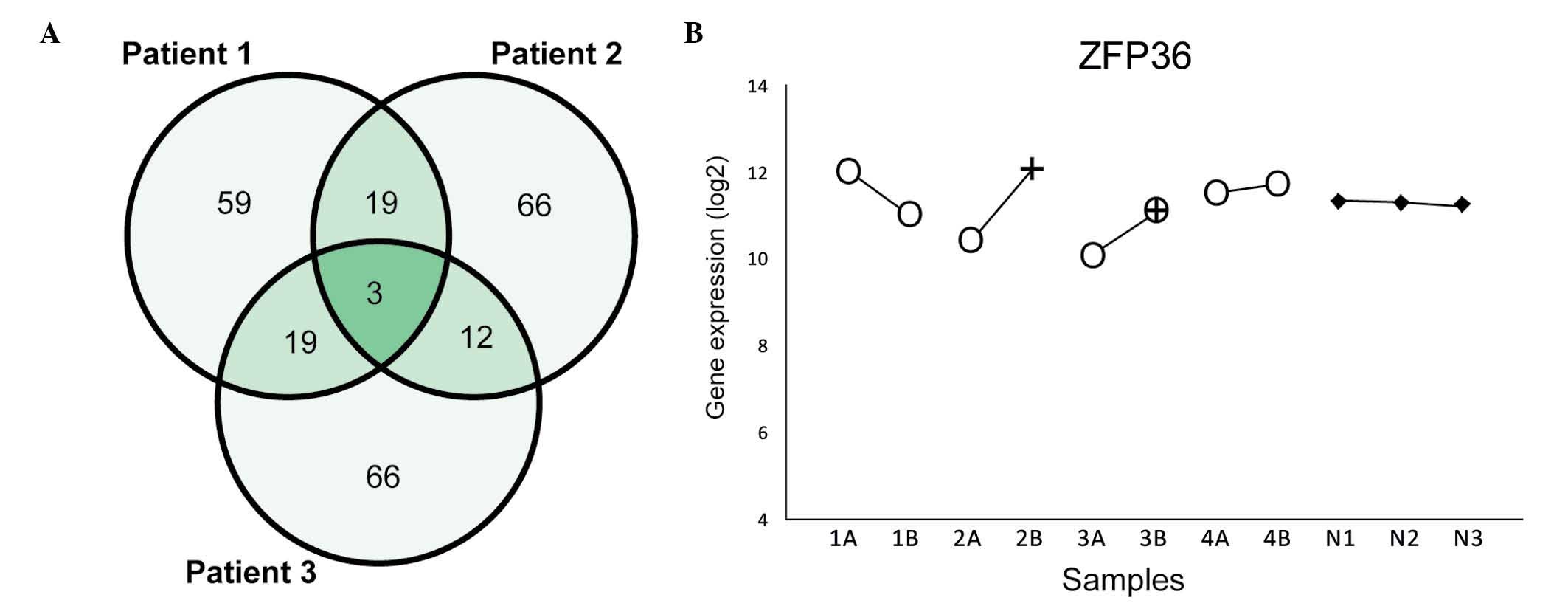|
1
|
Stewart B and Wild C: Cancer by organ
site: Cancers of the female genital organs. World Cancer Report
2014Cancer by Organ Site: Cancers of the female genital Organs.
Lyon: International Agency for Research on Cancer; pp. 465–481.
2014
|
|
2
|
Auersperg N: The origin of ovarian
cancers-hypotheses and controversies. Front Biosci (Schol Ed).
5:709–719. 2013.PubMed/NCBI
|
|
3
|
Prat J: Ovarian carcinomas: Five distinct
diseases with different origins, genetic alterations, and
clinicopathological features. Virchows Arch. 460:237–249. 2012.
View Article : Google Scholar : PubMed/NCBI
|
|
4
|
Kurman RJ, Ellenson L Hendrick and Ronnett
BM: Blaustein's Pathology of the Female Genital Tract. Springer;
New York, NY: 2011
|
|
5
|
Kurman RJ and Shih IeM: The origin and
pathogenesis of epithelial ovarian cancer: A proposed unifying
theory. Am J Surg Pathol. 34:433–443. 2010. View Article : Google Scholar : PubMed/NCBI
|
|
6
|
Pejovic T, Heim S, Mandahl N, Elmfors B,
Furgyik S, Flodérus UM, Helm G, Willén H and Mitelman F: Bilateral
ovarian carcinoma: Cytogenetic evidence of unicentric origin. Int J
Cancer. 47:358–361. 1991. View Article : Google Scholar : PubMed/NCBI
|
|
7
|
Micci F, Haugom L, Ahlquist T, Abeler VM,
Trope CG, Lothe RA and Heim S: Tumor spreading to the contralateral
ovary in bilateral ovarian carcinoma is a late event in clonal
evolution. J Oncol. 2010:6463402010.PubMed/NCBI
|
|
8
|
Khalique L, Ayhan A, Whittaker JC, Singh
N, Jacobs IJ, Gayther SA and Ramus SJ: The clonal evolution of
metastases from primary serous epithelial ovarian cancers. Int J
Cancer. 124:1579–1586. 2009. View Article : Google Scholar : PubMed/NCBI
|
|
9
|
Adib TR, Henderson S, Perrett C, Hewitt D,
Bourmpoulia D, Ledermann J and Boshoff C: Predicting biomarkers for
ovarian cancer using gene-expression microarrays. Br J Cancer.
90:686–692. 2004. View Article : Google Scholar : PubMed/NCBI
|
|
10
|
Lancaster JM, Dressman HK, Clarke JP,
Sayer RA, Martino MA, Cragun JM, Henriott AH, Gray J, Sutphen R,
Elahi A, et al: Identification of genes associated with ovarian
cancer metastasis using microarray expression analysis. Int J
Gynecol Cancer. 16:1733–1745. 2006. View Article : Google Scholar : PubMed/NCBI
|
|
11
|
Brodsky AS, Fischer A, Miller DH, Vang S,
MacLaughlan S, Wu HT, Yu J, Steinhoff M, Collins C, Smith PJ, et
al: Expression profiling of primary and metastatic ovarian tumors
reveals differences indicative of aggressive disease. PloS One.
9:e944762014. View Article : Google Scholar : PubMed/NCBI
|
|
12
|
Pejovic T, Heim S, Mandahl N, Baldetorp B,
Elmfors B, Flodérus UM, Furgyik S, Helm G, Himmelmann A, Willén H,
et al: Chromosome aberrations in 35 primary ovarian carcinomas.
Genes Chromosomes Cancer. 4:58–68. 1992. View Article : Google Scholar : PubMed/NCBI
|
|
13
|
Pejovic T, Heim S, Mandahl N, Elmfors B,
Flodérus UM, Furgyik S, Helm G, Willén H and Mitelman F: Consistent
occurrence of a 19p+ marker chromosome and loss of 11p material in
ovarian seropapillary cystadenocarcinomas. Genes Chromosomes
Cancer. 1:167–171. 1989. View Article : Google Scholar : PubMed/NCBI
|
|
14
|
Jenkins RB, Bartelt D Jr, Stalboerger P,
Persons D, Dahl RJ, Podratz K, Keeney G and Hartmann L: Cytogenetic
studies of epithelial ovarian carcinoma. Cancer Genet Cytogenet.
71:76–86. 1993. View Article : Google Scholar : PubMed/NCBI
|
|
15
|
Taetle R, Aickin M, Yang JM, Panda L,
Emerson J, Roe D, Adair L, Thompson F, Liu Y, Wisner L, et al:
Chromosome abnormalities in ovarian adenocarcinoma: I. Nonrandom
chromosome abnormalities from 244 cases. Genes Chromosomes Cancer.
25:290–300. 1999. View Article : Google Scholar : PubMed/NCBI
|
|
16
|
Smebye ML, Sveen A, Haugom L, Davidson B,
Tropé CG, Lothe RA, Heim S, Skotheim RI and Micci F: Chromosome 19
rearrangements in ovarian carcinomas: Zinc finger genes are
particularly targeted. Genes Chromosomes Cancer. 53:558–567. 2014.
View Article : Google Scholar : PubMed/NCBI
|
|
17
|
Irizarry RA, Hobbs B, Collin F,
Beazer-Barclay YD, Antonellis KJ, Scherf U and Speed TP:
Exploration, normalization and summaries of high density
oligonucleotide array probe level data. Biostatistics. 4:249–264.
2003. View Article : Google Scholar : PubMed/NCBI
|
|
18
|
Dysvik B and Jonassen I: J-Express:
Exploring gene expression data using Java. Bioinformatics.
17:369–370. 2001. View Article : Google Scholar : PubMed/NCBI
|
|
19
|
Bashashati A, Ha G, Tone A, Ding J,
Prentice LM, Roth A, Rosner J, Shumansky K, Kalloger S, Senz J, et
al: Distinct evolutionary trajectories of primary high-grade serous
ovarian cancers revealed through spatial mutational profiling. J
Pathol. 231:21–34. 2013. View Article : Google Scholar : PubMed/NCBI
|
|
20
|
Al-Souhibani N, Al-Ahmadi W, Hesketh JE,
Blackshear PJ and Khabar KS: The RNA-binding zinc-finger protein
tristetraprolin regulates AU-rich mRNAs involved in breast
cancer-related processes. Oncogene. 29:4205–4215. 2010. View Article : Google Scholar : PubMed/NCBI
|
|
21
|
Dorn J, Harbeck N, Kates R, Gkazepis A,
Scorilas A, Soosaipillai A, Diamandis E, Kiechle M, Schmalfeldt B
and Schmitt M: Impact of expression differences of
kallikrein-related peptidases and of uPA and PAI-1 between primary
tumor and omentum metastasis in advanced ovarian cancer. Ann Oncol.
22:877–883. 2011. View Article : Google Scholar : PubMed/NCBI
|
|
22
|
Ganesan K, Ivanova T, Wu Y, Rajasegaran V,
Wu J, Lee MH, Yu K, Rha SY, Chung HC, Ylstra B, et al: Inhibition
of gastric cancer invasion and metastasis by PLA2G2A, a novel
beta-catenin/TCF target gene. Cancer Res. 68:4277–4286. 2008.
View Article : Google Scholar : PubMed/NCBI
|
|
23
|
Heit C, Jackson BC, McAndrews M, Wright
MW, Thompson DC, Silverman GA, Nebert DW and Vasiliou V: Update of
the human and mouse SERPIN gene superfamily. Hum Genomics.
7:222013. View Article : Google Scholar : PubMed/NCBI
|
|
24
|
Schmalfeldt B, Kuhn W, Reuning U, Pache L,
Dettmar P, Schmitt M, Jänicke F, Höfler H and Graeff H: Primary
tumor and metastasis in ovarian cancer differ in their content of
urokinase-type plasminogen activator, its receptor and inhibitors
types 1 and 2. Cancer Res. 55:3958–3963. 1995.PubMed/NCBI
|
|
25
|
Fang H, Placencio VR and DeClerck YA:
Protumorigenic activity of plasminogen activator inhibitor-1
through an antiapoptotic function. J Natl Cancer Inst.
104:1470–1484. 2012. View Article : Google Scholar : PubMed/NCBI
|
|
26
|
Mashiko S, Kitatani K, Toyoshima M,
Ichimura A, Dan T, Usui T, Ishibashi M, Shigeta S, Nagase S, Miyata
T and Yaegashi N: Inhibition of plasminogen activator inhibitor-1
is a potential therapeutic strategy in ovarian cancer. Cancer Biol
Ther. 16:253–260. 2015. View Article : Google Scholar : PubMed/NCBI
|
|
27
|
Kuhn W, Schmalfeldt B, Reuning U, Pache L,
Berger U, Ulm K, Harbeck N, Späthe K, Dettmar P, Höfler H, et al:
Prognostic significance of urokinase (uPA) and its inhibitor PAI-1
for survival in advanced ovarian carcinoma stage FIGO IIIc. Br J
Cancer. 79:1746–1751. 1999. View Article : Google Scholar : PubMed/NCBI
|
|
28
|
Sakakibara T, Hibi K, Koike M, Fujiwara M,
Kodera Y, Ito K and Nakao A: Plasminogen activator inhibitor-1 as a
potential marker for the malignancy of gastric cancer. Cancer Sci.
97:395–399. 2006. View Article : Google Scholar : PubMed/NCBI
|
|
29
|
Berger DH: Plasmin/plasminogen system in
colorectal cancer. World J Surg. 26:767–771. 2002. View Article : Google Scholar : PubMed/NCBI
|
|
30
|
Zubac DP, Wentzel-Larsen T, Seidal T and
Bostad L: Type 1 plasminogen activator inhibitor (PAI-1) in clear
cell renal cell carcinoma (CCRCC) and its impact on angiogenesis,
progression and patient survival after radical nephrectomy. BMC
Urol. 10:202010. View Article : Google Scholar : PubMed/NCBI
|
|
31
|
Offersen BV, Alsner J, Ege Olsen K,
Riisbro R, Brünner N, Sørensen FB, Sørensen BS, Schlemmer BO and
Overgaard J: A comparison among HER2, TP53, PAI-1, angiogenesis and
proliferation activity as prognostic variables in tumours from 408
patients diagnosed with early breast cancer. Acta Oncol.
47:618–632. 2008. View Article : Google Scholar : PubMed/NCBI
|
|
32
|
Affer M, Chesi M, Chen WD, Keats JJ,
Demchenko YN, Tamizhmani K, Garbitt VM, Riggs DL, Brents LA, et al:
Promiscuous MYC locus rearrangements hijack enhancers but mostly
super-enhancers to dysregulate MYC expression in multiple myeloma.
Leukemia. 28:1725–1735. 2014. View Article : Google Scholar : PubMed/NCBI
|
|
33
|
Pollack JR, Sørlie T, Perou CM, Rees CA,
Jeffrey SS, Lonning PE, Tibshirani R, Botstein D, Børresen-Dale AL
and Brown PO: Microarray analysis reveals a major direct role of
DNA copy number alteration in the transcriptional program of human
breast tumors. Proc Natl Acad Sci USA. 99:12963–12968. 2002.
View Article : Google Scholar : PubMed/NCBI
|
|
34
|
Hyman E, Kauraniemi P, Hautaniemi S, Wolf
M, Mousses S, Rozenblum E, Ringnér M, Sauter G, Monni O, Elkahloun
A, et al: Impact of DNA amplification on gene expression patterns
in breast cancer. Cancer Res. 62:6240–6245. 2002.PubMed/NCBI
|
|
35
|
Graff JR, Konicek BW, Deddens JA, Chedid
M, Hurst BM, Colligan B, Neubauer BL, Carter HW and Carter JH:
Expression of group IIa secretory phospholipase A2 increases with
prostate tumor grade. Clin Cancer Res. 7:3857–3861. 2001.PubMed/NCBI
|
|
36
|
Cancer Genome Atlas Research Network, .
Integrated genomic analyses of ovarian carcinoma. Nature.
474:609–615. 2011. View Article : Google Scholar : PubMed/NCBI
|
|
37
|
Van Tubergen EA, Banerjee R, Liu M, Broek
R Vander, Light E, Kuo S, Feinberg SE, Willis AL, Wolf G, Carey T,
et al: Inactivation or loss of TTP promotes invasion in head and
neck cancer via transcript stabilization and secretion of MMP9,
MMP2 and IL-6. Clin Cancer Res. 19:1169–1179. 2013. View Article : Google Scholar : PubMed/NCBI
|
|
38
|
Veskimäe K, Staff S, Tabaro F, Nykter M,
Isola J and Mäenpää J: Microarray analysis of differentially
expressed genes in ovarian and fallopian tube epithelium from
risk-reducing salpingo-oophorectomies. Genes Chromosomes Cancer.
54:276–287. 2015. View Article : Google Scholar : PubMed/NCBI
|

















